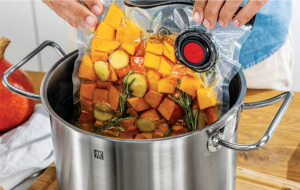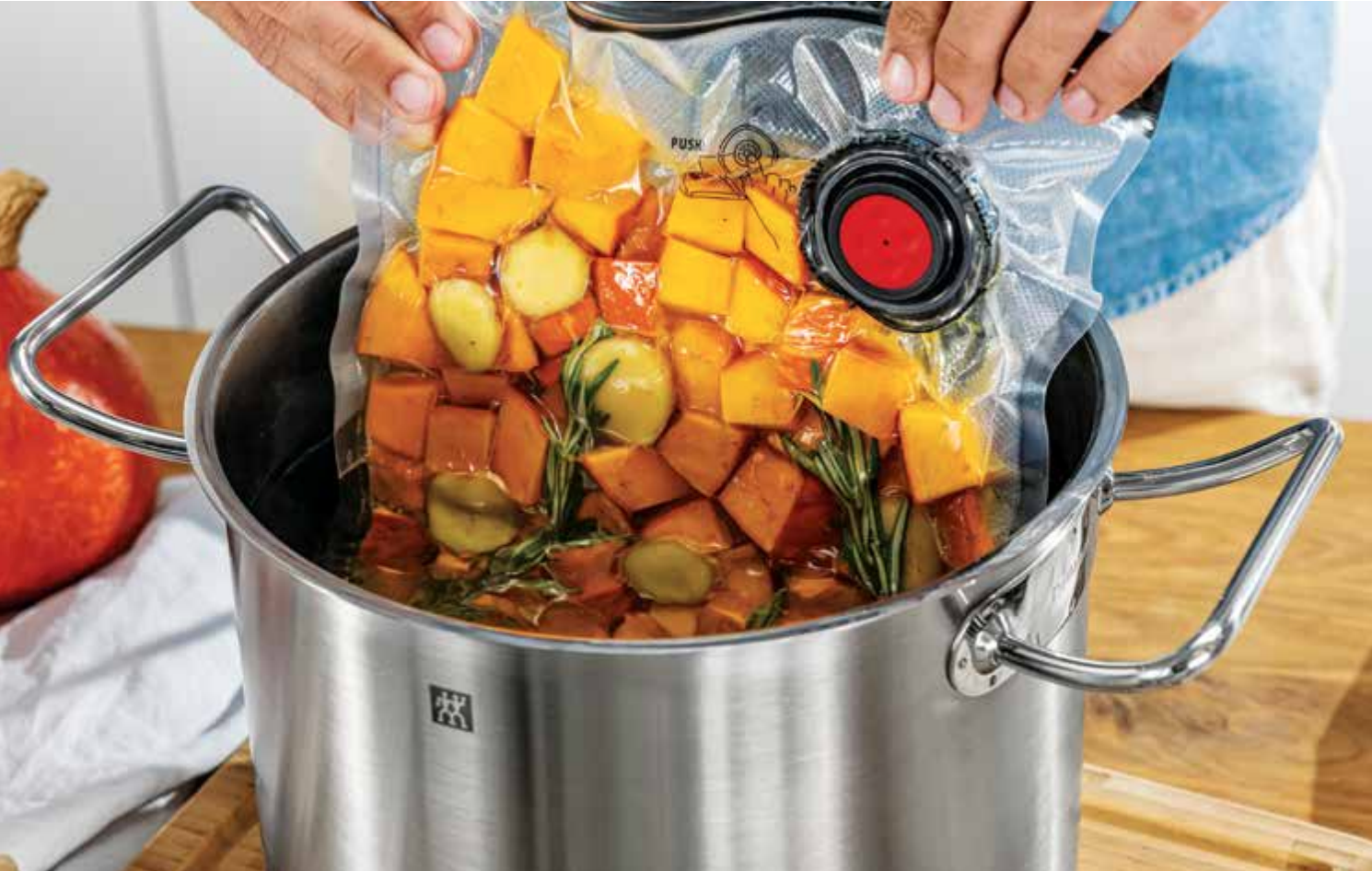
By Sally Kilbridge
Restaurant-quality dinner with minimal hands-on effort? I’m game
Sous vide cooking has been around for a while. Submerging vacuum-sealed food in a hot water bath started popping up in restaurants 20 years ago. It produced food so evenly cooked, so tender, people claimed even pork chops became dinner-party special.
After a 2006 episode of “Iron Chef” in which the challenger sous vided much of the meal, intrepid home kitchens joined the movement. While “sous vide” (literally, “under vacuum”) equipment used to be a major investment, a new generation of immersion circulators makes it a tempting toy. I decided to test Zwilling’s Enfinigy Sous Vide Stick. Germany’s Zwilling brand has been around for nearly 300 years, so I figured I’d be in good hands.
The eggs and I
Surprise No. 1: the heft. At 4 lbs., the Zwilling Sous Vide wand could double as a small weapon. Thankfully it’s a setit-and-forget-it gadget. The clip that attaches it to a cooking pot is super-sturdy, and the wand seems built to last. I realized before I finished opening the box that I had neglected some key prep: Buying the special bags and sealer that most sous vide recipes recommend. After placing an overnight order, I decided to make what food bloggers call sous vide “poached” eggs for breakfast.
Eggs don’t require sealing because as long as you don’t crack the shells, nature has done the work for you. Following directions I found online, I clamped the stick inside a tall pot, filled it with water, set the temperature to 167° and a timer for 13 minutes, and carefully lowered in one egg.
It was not a happy morning.
After cooking several eggs at several temperatures and times — some “experts” called for poaching an egg an excruciating 75 minutes — I ended up with yolks that ranged from liquid to rubber, and whites that were consistently watery. Settling for buttered toast, I started tracking the UPS truck.
Riding the sous vide rollercoaster
The next day, vacuum sealer in hand, I started with what sounded like an idiot-proof dish. I seasoned a chicken breast with salt and pepper, dropped it into a vacuum bag, and used the sealer to suck out all the air. This time I stuck to a Zwilling recipe and let the chicken cook at 144°F while I went about my life.
Seventy-five minutes later, you could have knocked me over with a sous vide wand when I opened the bag to reveal a pale, moist, perfectly done chicken breast. As far as plain chicken goes, this was about as good as it gets. Flush with success, I told my husband that dinner would be “the best salmon you’ve ever had.”
Online discussions of sous vide salmon unanimously called it “silky” and “buttery.” I decided to follow Zwilling’s cooking instructions, but after slipping the fish into a large bag, added my own quick soy-ginger sauce. Crikey!
The vacuum began sucking the sauce out of the bag, very much against manufacturer warnings. I turned it off, figured things looked good enough, and dunked the bag into a 120°F pot. I will say, 43 minutes later, placing those supple filets on our plates, I felt that I’d nailed it. “Um, it’s a lot moister than
your usual salmon,” frowned my husband. Hmph, I thought, that’s the point. However, after one bite I had to agree that it was a little, er, raw. Seems that 120°F is too low for cooking farmed salmon. Perhaps Zwilling’s test kitchen uses wild salmon, which has a firmer texture and a higher price tag. Ours ended up making a pleasant salmon tartare.
The other white meat
I soldiered on. Pork loin is lean and affordable, and very easy to dry out. Enthusiasts insist sous vide utterly transforms it, so I chose pork tenderloin for my next experiment.
Prep took 40 seconds. Salt, pepper, a few fresh rosemary sprigs, pop it into a sous vide bag, and let it cook at 140°F. Two hours later, I opened the bag to find the rosemary adhered to a wrinkly piece of pinky-grey pork. I’d been warned about this — sous vide cooking won’t brown your food; finishing it in a sauté pan with oil or butter improves both look and texture. So I went the extra mile, dirtied another pan, got some nice browning, and finally sat down.
I took my husband’s “mmm, tender” as proof of success. Flavor-wise it wasn’t exactly Julia Child (I had worried that a marinade, which would have helped with the blandness, would result in another vacuum incident) but this was without a doubt the most perfectly cooked piece of pork I’d ever made.
Beef, the final frontier
Have you ever tried cooking a petite sirloin steak? It sounds so nice – “petite” and “sirloin” conjure images of a melt-in-your-mouth treat. Truth is this is a tough little bugger, if an inexpensive one. I felt it would be the ultimate test of the sous vide system.
At my local grocery store, a package of two petite sirloins was $6.45, less than a 10-piece serving of Chicken McNuggets. With considerable skepticism I followed my usual routine: shower with kosher salt and freshly ground pepper, pop the steaks in a bag, vacuum out the air, and place in a 140°F bath. The recipe I used gave a generous time window, “90 minutes to four hours,” and for the sake of convenience I settled on two hours. I didn’t have to worry about over-cooking, as sous vide ensures your food never rises above the set temperature. I took an additional five minutes at the end to brown the cooked steaks in a cast iron pan with a bit of butter.
And the result? Miraculous.
Ours was a largely silent meal, as my husband and I cut into our tender, juicy, beautifully medium-rare steaks, nodding our heads and almost humming. Was it as good as a petit filet mignon? It was pretty dang close.
The upshot
Converts say that sous vide cooking is just one tool in a cook’s repertoire, and I agree. I’ll use the Zwilling stick when preparing things like a big batch of chicken salad for a picnic. And no question I’m going to sous vide sirloins for my next dinner party, while using the idle time to whip up a mushroom sauce.
But it turns out I also like the control that comes with being a hands-on cook. I like adjusting seasonings and tasting as I go. And come 5 P.M., clanking around the kitchen for an hour is a natural way to separate work-from-home life and relaxat-home life. Then again, if I had less time to devote to cooking, a set-it-and-forget-it sous-vide stick would probably be my new best friend.
So there you have it. Eggs, bad. Steak, great. And a lot of in-between. As test-drives go, this
was a tasty one.
To read more from Park City HOME Winter 2023 magazine, click
here.


